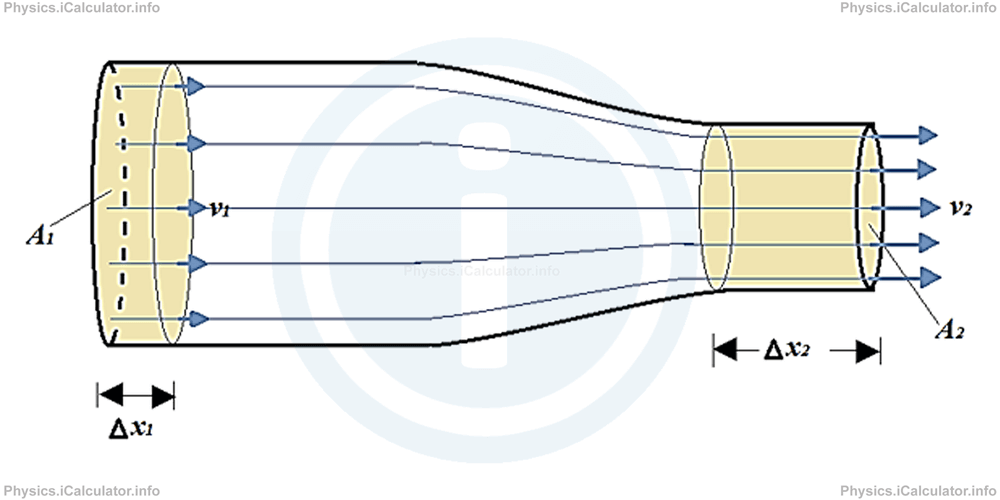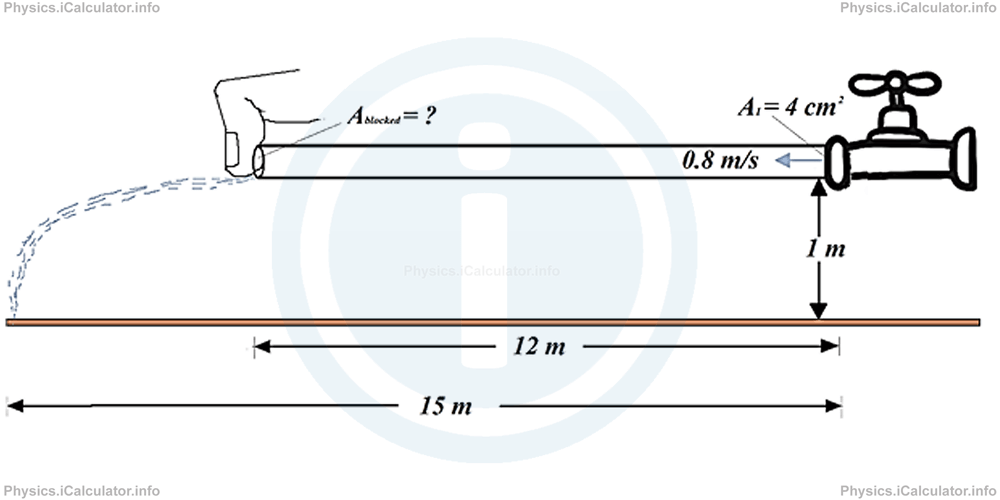Menu
Physics Lesson 9.6.2 - The Equation of Continuity
Please provide a rating, it takes seconds and helps us to keep this resource free for all to use
Welcome to our Physics lesson on The Equation of Continuity, this is the second lesson of our suite of physics lessons covering the topic of Bernoulli Equation, you can find links to the other lessons within this tutorial and access additional physics learning resources below this lesson.
The Equation of Continuity
Let us consider again the first scenario discussed in the "Introduction" paragraph. Thus, from experience we know that if we want to increase the flowing speed of water in order to reach the farthest parts of the garden, we must partially close the hose opening using the thumb. In this way, we decrease the flowing area in the output. This means the cross sectional flowing area and the flowing speed are somehow inversely proportional to each other (smaller cross-sectional area → higher flowing speed and larger cross sectional area → lower flowing speed.
But, how can we prove mathematically the above assumption? For this, let's consider a kind of bottle opened in both ends as shown below. 
Let's consider a liquid sample flowing in the two ends of the tube (the coloured sections); one at the beginning and the other at the end of the tube. Since there is the same amount of liquid in both sections (m1 = m2 = m and ρ1 = ρ2 = ρ), we have
This means that
Since the volume of a cylinder is calculated by the formula V = A × Δx (where Δx here stand for height of cylinder), we obtain for volume in both sections
Here the cylinder height Δx acts as a kind of particles displacement. From uniform motion we know that
where v here represents the flowing speed and Δt the time interval during which this flow occurs.
Since there is the same fluid in both coloured part and given that ideal liquids are incompressible, we have for the flowing rate in both sections
Therefore, Δt1 = Δt2 = Δt. Hence, substituting ∆x = v × ∆t in the equation
for both sections, we obtain
Simplifying Δt from both sides, we obtain
Thus, we proved the above assumption, i.e. the cross sectional area of a flowing fluid and its flowing speed are inversely proportional to each other. The above equation is known as the "equation of continuity for ideal fluids".
Example 1
A 4 cm thick hose is connected to a water tap from which water comes out at 0.8 m/s. The hose is 12 m long if stretched. How much area in the output part of the hose must be block with thumb so that water reaches a point, which is 15 m away from the tap? The hose is taken in the horizontal position at 1 m above the ground. Take g = 10 m/s2 if needed. 
Solution 1
First, we have to determine by what speed the water must come out from the hose, i.e. to determine v2 in the equation of continuity. This speed is calculated by kinematic methods. Thus, since water comes out horizontally from the hose (v0y = 0) and the height from the ground is h = 1 m, we obtain for the falling time t:
= √2 × 1/10
= 0.45 s
Hence, given that the horizontal distance of water is Δs = 15 m - 12 m = 3 m, we obtain for the output speed v2 (which corresponds to v0x in kinematics):
= 3 m/0.45 s
= 6.67 m/s
Now, let's calculate the flowing area A2 allowed at the output by blocking the rest with thumb. Given that A1 = 4 cm2, v1 = 0.8 m/s and v2 = 6.67 m/s, we obtain from the equation of continuity
A2 = A1 × v1/v2
= 4 × 0.8/6.67
≈ 0.48 cm2
Thus, the area we must block by thumb is
= 4 cm2 - 0.48 cm2
= 3.52 cm2
You have reached the end of Physics lesson 9.6.2 The Equation of Continuity. There are 3 lessons in this physics tutorial covering Bernoulli Equation, you can access all the lessons from this tutorial below.
More Bernoulli Equation Lessons and Learning Resources
Whats next?
Enjoy the "The Equation of Continuity" physics lesson? People who liked the "Bernoulli Equation lesson found the following resources useful:
- Continuity Feedback. Helps other - Leave a rating for this continuity (see below)
- Density and Pressure Physics tutorial: Bernoulli Equation. Read the Bernoulli Equation physics tutorial and build your physics knowledge of Density and Pressure
- Density and Pressure Revision Notes: Bernoulli Equation. Print the notes so you can revise the key points covered in the physics tutorial for Bernoulli Equation
- Density and Pressure Practice Questions: Bernoulli Equation. Test and improve your knowledge of Bernoulli Equation with example questins and answers
- Check your calculations for Density and Pressure questions with our excellent Density and Pressure calculators which contain full equations and calculations clearly displayed line by line. See the Density and Pressure Calculators by iCalculator™ below.
- Continuing learning density and pressure - read our next physics tutorial: Adhesive and Cohesive Forces. Surface Tension and Capillarity
Help others Learning Physics just like you
Please provide a rating, it takes seconds and helps us to keep this resource free for all to use
We hope you found this Physics lesson "Bernoulli Equation" useful. If you did it would be great if you could spare the time to rate this physics lesson (simply click on the number of stars that match your assessment of this physics learning aide) and/or share on social media, this helps us identify popular tutorials and calculators and expand our free learning resources to support our users around the world have free access to expand their knowledge of physics and other disciplines.